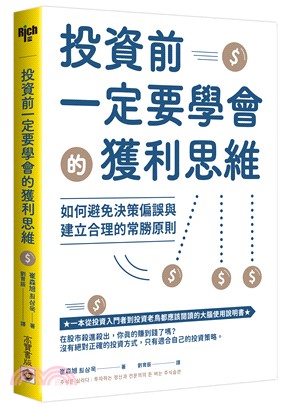Bioelectrochemistry - Fundamentals, Experimentals Techniques And Applications
- ISBN13:9780470843642
- 出版社:John Wiley & Sons Inc
- 作者:Bartlett
- 裝訂/頁數:精裝/496頁
- 出版日:2008/04/11
商品簡介
By bringing together these different aspects, this work provides a unique source of information in this area, approaching the subject from a cross-disciplinary viewpoint.
目次
Preface.
1 Bioenergetics and Biological Electron Transport (Philip N. Bartlett).
1.1 Introduction.
1.2 Biological Cells.
1.3 Chemiosmosis.
1.3.1 The Proton Motive Force.
1.3.2 The Synthesis of ATP.
1.4 Electron Transport Chains.
1.4.1 The Mitochondrion.
1.4.2 The NADH–CoQ Reductase Complex.
1.4.3 The Succinate–CoQ Reductase Complex.
1.4.4 The CoQH2–Cyt c Reductase Complex.
1.4.5 The Cyt c Oxidase Complex.
1.4.6 Electron Transport Chains in Bacteria.
1.4.7 Electron Transfer in Photosynthesis.
1.4.8 Photosystem II.
1.4.9 Cytochrome bf Complex.
1.4.10 Photosystem I.
1.4.11 Bacterial Photosynthesis.
1.5 Redox Components.
1.5.1 Quinones.
1.5.2 Flavins.
1.5.3 NAD(P)H.
1.5.4 Hemes.
1.5.5 Iron–Sulfur Clusters.
1.5.6 Copper Centres.
1.6 Governing Principles.
1.6.1 Spatial Separation.
1.6.2 Energetics: Redox Potentials.
1.6.3 Kinetics: Electron Transfer Rate Constants.
1.6.4 Size of Proteins.
1.6.5 One-Electron and Two-Electron Couples.
1.7 ATP Synthase.
1.8 Conclusion.
References.
2 Electrochemistry of Redox Enzymes (James F. Rusling, Bingquan Wang and Sei-eok Yun).
2.1 Introduction.
2.1.1 Historical Perspective.
2.1.2 Examples of Soluble Mediators.
2.1.3 Development of Protein-Film Voltammetry and Direct Enzyme Electrochemistry.
2.2 Mediated Enzyme Electrochemistry.
2.2.1 Electron Mediation.
2.2.2 Wiring with Redox Metallopolymer Hydrogels.
2.2.3 Wiring with Conducting Polymers.
2.2.4 NAD(P)þ/NAD(P)H Dependent Enzymes.
2.2.5 Regeneration of NAD(P)H from NAD(P)þ.
2.2.6 Regeneration of NAD(P)þ from NAD(P)H.
2.3 Direct Electron Transfer between Electrodes and Enzymes.
2.3.1 Enzymes in Solution.
2.3.2 Enzyme-Film Voltammetry: Basic Theory.
2.3.3 Adsorbed and Coadsorbed Enzyme Monolayers.
2.3.4 Self-Assembled Monolayers and Covalently Attached Enzymes.
2.3.5 Enzymes on Carbon Nanotube Electrodes.
2.3.6 Enzymes in Lipid Bilayer Films.
2.3.7 Polyion Films and Layer-by-Layer Methods.
2.4 Outlook for the Future.
Acknowledgements.
References.
3 Biological Membranes and Membrane Mimics (Tibor Hianik).
3.1 Introduction.
3.2 Membrane Structure and Composition.
3.2.1 Membrane Structure.
3.2.2 Membrane Lipids.
3.2.3 Membrane Proteins.
3.3 Models of Membrane Structure.
3.3.1 Lipid Monolayers.
3.3.2 Bilayer Lipid Membranes (BLM).
3.3.3 Supported Bilayer Lipid Membranes.
3.3.4 Liposomes.
3.4 Ordering, Conformation and Molecular Dynamics of Lipid Bilayers.
3.4.1 Structural Parameters of Lipid Bilayers Measured by X-ray Diffraction.
3.4.2 Interactions between Bilayers.
3.4.3 Dynamics and Order Parameters of Bilayers Determined by EPR and NMR Spectroscopy and by Optical Spectroscopy Methods.
3.5 Phase Transitions of Lipid Bilayers.
3.5.1 Lyotropic and Thermotropic Transitions.
3.5.2 Thermodynamics of Phase Transitions.
3.5.3 Trans–Gauche Isomerization.
3.5.4 Order Parameter.
3.5.5 Cooperativity of Transition.
3.5.6 Theory of Phase Transitions.
3.6 Mechanical Properties of Lipid Bilayers.
3.6.1 Anisotropy of Mechanical Properties of Lipid Bilayers.
3.6.2 The Model of an Elastic Bilayer.
3.6.3 Mechanical Properties of Lipid Bilayers and Protein–Lipid Interactions.
3.7 Membrane Potentials.
3.7.1 Diffusion Potential.
3.7.2 Electrostatic Potentials.
3.7.3 Methods of Surface Potential Measurement.
3.8 Dielectric Relaxation.
3.8.1 The Basic Principles of the Measurement of Dielectric Relaxation.
3.8.2 Application of the Method of Dielectric Relaxation to BLMs and sBLMs.
3.9 Transport Through Membranes.
3.9.1 Passive Diffusion.
3.9.2 Facilitated Diffusion of Charged Species Across Membranes.
3.9.3 Mechanisms of Ionic Transport.
3.9.4 Active Transport Systems.
3.10 Membrane Receptors and Cell Signaling.
3.10.1 Physical Reception.
3.10.2 Principles of Hormonal Reception.
3.10.3 Taste and Smell Reception.
3.11 Lipid-Film Coated Electrodes.
3.11.1 Modification of Lipid-Film Coated Electrodes by Functional Macromolecules.
3.11.2 Bioelectrochemical and Analytical Applications of Lipid Coated Electrodes.
Acknowledgements.
References.
4 NAD(P)-Based Biosensors (L. Gorton and P. N. Bartlett).
4.1 Introduction.
4.2 Electrochemistry of NAD(P)þ/NAD(P)H.
4.3 Direct Electrochemical Oxidation of NAD(P)H.
4.3.1 General Observations.
4.3.2 Effect of Adsorption.
4.3.3 Mechanism and Kinetics.
4.4 Soluble Cofactors.
4.4.1 Implications of the Low Eo0 Value for Practical Applications.
4.4.2 Special Prerequisites for Biosensors Based on NAD(P)-Dependent Dehydrogenases.
4.5 Mediators for Electrocatalytic NAD(P)H Oxidation.
4.5.1 Other Mediating Functionalities and Metal Coated Electrodes.
4.5.2 Electropolymerisation.
4.5.3 Carbon Paste.
4.5.4 Gold Nanoparticles.
4.6 Construction of Biosensors from NAD(P)H-Dependent Dehydrogenases.
4.6.1 Entrapment Behind a Membrane.
4.6.2 Covalent Attachment to a Nylon Net or Membrane.
4.6.3 Cross-Linking.
4.6.4 Entrapment in a Polymer Film.
4.6.5 Carbon Paste.
4.6.6 Self-Assembled Monolayers.
4.7 Conclusions.
Acknowledgements.
References.
5 Glucose Biosensors (Josep M. Montornes, Mark S. Vreeke and Ioanis Katakis).
5.1 Introduction to Glucose Sensors.
5.2 Biosensors.
5.2.1 Types of Sensors.
5.2.2 Transduction Mode.
5.3 Application Areas.
5.3.1 Clinical.
5.3.2 Food and Fermentation.
5.4 Design Requirements.
5.4.1 Disposable Glucose Sensor.
5.4.2 Continuous Glucose Sensor.
5.4.3 Implantable Glucose Sensor.
5.5 Biosensor Construction.
5.5.1 Artificial Mediators.
5.5.2 Immobilization of GOx.
5.5.3 Inner and Outer Membrane Function.
5.6 From Product Design Requirements to Performance.
5.6.1 Design Exercise for the Disposable Glucose Sensor.
5.7 Conclusions.
Acknowledgement.
References.
6 Phenolic Biosensors (Ulla Wollenberger, Fred Lisdat, Andreas Rose and Katrin Streffer).
6.1 Introduction.
6.2 Enzymes Used for Phenol Biosensors.
6.2.1 Phenol Oxidation by Water-Producing Oxidases and Oxygenases.
6.2.2 Reducing Enzymes.
6.3 Design of Phenol Biosensors.
6.3.1 Oxygen Consumption.
6.3.2 Bioelectrocatalysis Based on Phenol-Oxidizing Enzymes.
6.3.3 Electrocatalytic Sensors Based on Quinone-Reducing Enzymes.
6.4 Applications.
6.4.1 Waste Water Treatment.
6.4.2 Sensitive Label Detectors.
6.4.3 Catecholamines.
6.5 Summary and Conclusions.
Acknowledgements.
References.
7 Whole-Cell Biosensors (H. Shiku, K. Nagamine, T. Kaya, T. Yasukawa and T. Matsue).
7.1 Introduction.
7.2 Whole-Cell Biosensors Probing Cellular Functions.
7.2.1 Redox Reactions in Whole Cells.
7.2.2 Responses on a Microbial Chip with Collagen Gel.
7.3 Whole-Cell Microdevices Fabricated Using Bio-MEMS Technologies.
7.3.1 Potentiometric Devices: LAPS and ISFET.
7.3.2 Other Electrochemical Devices: Amperometric and Impedance Sensors.
7.3.3 Improvement of Cell Culture within Microenvironments.
7.4 Genetically Engineered Whole-Cell Microdevices.
7.4.1 Sensors with Gene-Modified Bacteria.
7.4.2 Transcriptional Responses on a Microbial Chip with Collagen Gel.
7.4.3 Cellular Devices for High-Throughput Screening.
7.4.4 Microdevice for On-Chip Transfection and On-Chip Transformation.
7.5 Conclusions.
References.
8 Modelling Biosensor Responses (P. N. Bartlett, C. S. Toh, E. J. Calvo and V. Flexer).
8.1 Introduction.
8.2 Enzyme Kinetics.
8.2.1 Equilibrium and Steady-State.
8.2.2 Analysis of Enzyme Kinetic Data.
8.2.3 The Significance of KMS for Biosensor Applications.
8.3 Modelling Enzyme Electrodes.
8.3.1 The Flux Diagram for the Membrane|Enzyme|Electrode.
8.3.2 Solving the Coupled Diffusion/Reaction Problem for the Membrane Enzyme|Electrode.
8.3.3 Deriving a Complete Kinetic Model.
8.3.4 Experimental Verification of Approximate Analytical Kinetic Models.
8.4 Numerical Simulation Methods.
8.4.1 Explicit Numerical Methods.
8.4.2 The Crank–Nicholson Method.
8.4.3 Other Simulation Methods.
8.5 Modelling Redox Mediated Enzyme Electrodes.
8.5.1 Steady-State Kinetics.
8.5.2 Homogeneous Mediated Enzyme Electrode.
8.6 Modelling Homogeneous Enzyme with Attached Redox Mediator.
8.7 Non-Steady-State Techniques for Homogeneous Enzyme Systems.
8.7.1 Extraction of Kinetic Parameters.
8.8 The Heterogeneous Mediated Mechanism.
8.8.1 Enzyme Monolayers with Soluble Redox Mediator.
8.8.2 Enzyme Multilayers.
8.9 Conclusions.
Acknowledgements.
References.
9 Bioelectrosynthesis–Electrolysis and Electrodialysis (Derek Pletcher).
9.1 Introduction.
9.2 Setting the Scene.
9.2.1 Electrolytic Production of Organic Compounds.
9.2.2 Technological Factors.
9.2.3 Enzymes in Organic Synthesis.
9.2.4 Combining Enzyme Chemistry and Electrosynthesis.
9.3 Mechanisms of and Approaches to Bioelectrosynthesis.
9.3.1 Homogeneous Systems.
9.3.2 Electrode Coatings.
9.4 Examples of Syntheses.
9.4.1 The Oxidation of Alcohols and Diols.
9.4.2 The Oxidation of 4-Alkylphenols.
9.4.3 The Synthesis of Dihydroxyacetone Phosphate.
9.4.4 The Site Specific Oxidation of Sugars.
9.4.5 Hydroxylation of Unactivated C–H Bonds.
9.4.6 Reduction of Carbonyl Compounds.
9.4.7 Hydrogenation.
9.4.8 Conclusions.
9.5 Electrodialysis.
9.6 Conclusions.
References.
10 Biofuel Cells (G. Tayhas R. Palmore).
10.1 Introduction.
10.2 Fundamentals of Fuel Cells.
10.2.1 How Fuel Cells Work.
10.2.2 Equations that Govern the Performance of a Fuel Cell.
10.3 Economics of Conventional Fuel Cells and Biofuel Cells.
10.4 Biofuel Cells that use Micro-Organisms as the Catalytic Element.
10.5 Biofuel Cells that use Oxidoreductases as the Catalytic Element.
10.6 Future Directions in Biofuel Cell Research.
Acknowledgements.
References.
11 Electrochemical Immunoassays (Julia Yakovleva and Jenny Emneus).
11.1 Introduction.
11.2 Basic Concepts in Immunoassay.
11.2.1 Antibodies: Structure, Properties and Production.
11.2.2 Classification of Immunoassays.
11.3 Electrochemical Immunoassays (ECIA).
11.3.1 Labels in ECIAs.
11.3.2 Electrochemical Detection Principles.
11.4 Different Assay Formats and Applications.
11.4.1 Heterogeneous ECIA.
11.4.2 Homogeneous ECIAs.
11.4.3 Electrochemical Immunosensors.
11.5 Future Perspectives and Recent Trends.
References.
12 Electrochemical DNA Assays (Ana Maria Oliveira-Brett).
12.1 Introduction.
12.2 Electrochemistry of DNA.
12.2.1 Reduction.
12.2.2 Oxidation.
12.3 Adsorption of DNA at Electrode Surfaces.
12.3.1 Guanine Adsorbates.
12.3.2 Adsorbed dsDNA and ssDNA.
12.4 Electrochemistry for Sensing/Probing DNA Interactions.
12.4.1 Biomarkers for DNA Damage.
12.4.2 DNA–Metal Interactions.
12.4.3 DNA–Drug Interactions.
12.5 DNA Electrochemical Biosensors.
12.5.1 In Situ DNA Oxidative Damage.
12.5.2 DNA Hybridisation.
12.5.3 DNA Microarrays.
12.6 Conclusions.
Acknowledgements.
References.
13 In Vivo Applications: Glucose Monitoring, Fuel Cells (P. Vadgama and M. Schoenleber).
13.1 Introduction.
13.2 Biocompatibility.
13.2.1 General Concepts.
13.2.2 Protein Constituents.
13.2.3 Blood.
13.2.4 Tissue.
13.3 Materials Interfacing Strategy.
13.4 Implanted Glucose Biosensors.
13.4.1 Electrode Designs for Tissue Monitoring.
13.4.2 Electrode Designs for Blood Monitoring.
13.4.3 Early Phase Tissue Response.
13.4.4 Open Microflow.
13.4.5 Bioelectrochemical Fuel Cells.
13.5 Conclusions.
References.
Index.
主題書展
更多主題書展
更多書展本週66折
您曾經瀏覽過的商品
購物須知
外文書商品之書封,為出版社提供之樣本。實際出貨商品,以出版社所提供之現有版本為主。部份書籍,因出版社供應狀況特殊,匯率將依實際狀況做調整。
無庫存之商品,在您完成訂單程序之後,將以空運的方式為你下單調貨。為了縮短等待的時間,建議您將外文書與其他商品分開下單,以獲得最快的取貨速度,平均調貨時間為1~2個月。
為了保護您的權益,「三民網路書店」提供會員七日商品鑑賞期(收到商品為起始日)。
若要辦理退貨,請在商品鑑賞期內寄回,且商品必須是全新狀態與完整包裝(商品、附件、發票、隨貨贈品等)否則恕不接受退貨。
























